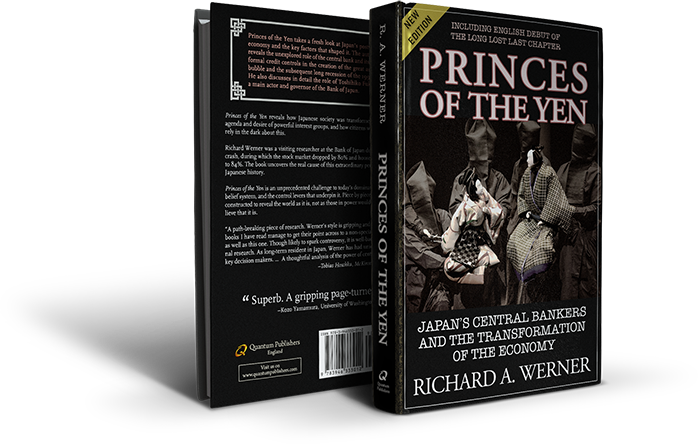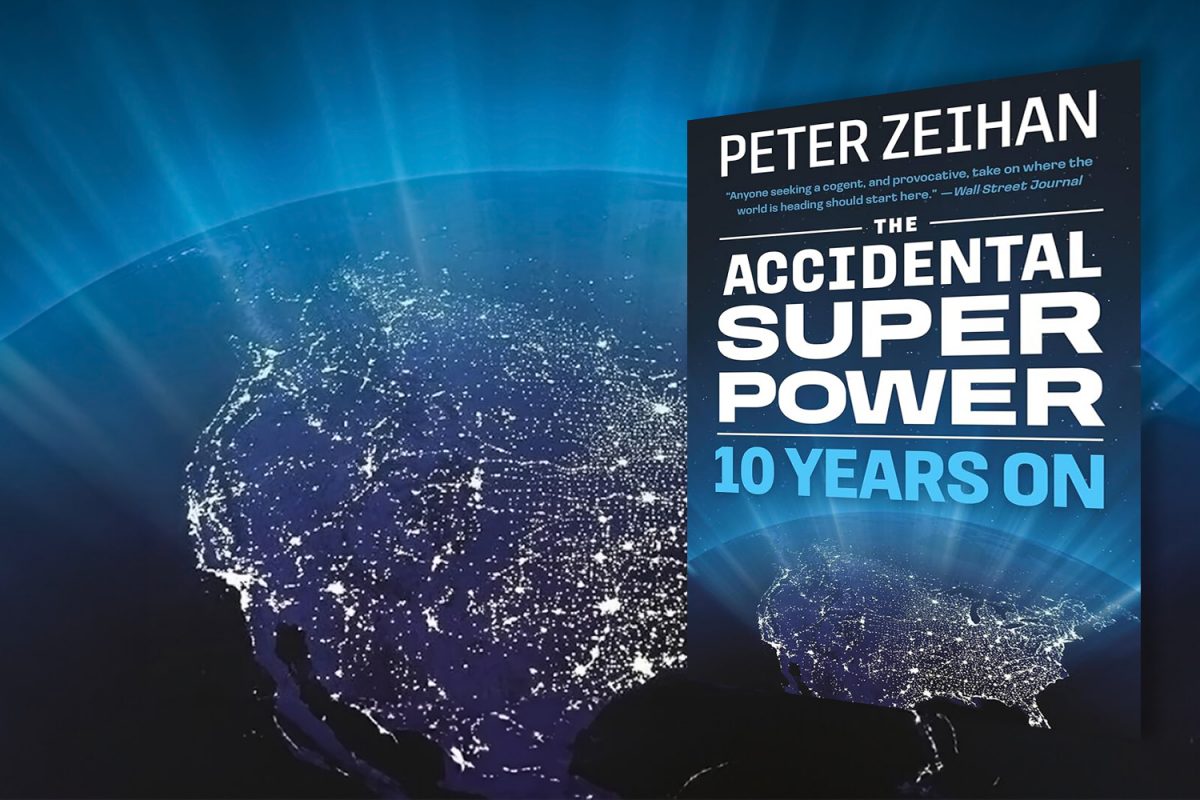Book Review: Princes of the Yen: Japan’s Central Bankers and the Transformation of the Economy
Richard Werner
2001
Princes of the Yen, Documentary adaption
2014
 Japan rose from the ashes after World War Two to become the industrial giant of the
Japan rose from the ashes after World War Two to become the industrial giant of the
world. In the 1970’s Japan within decades had gone from developed-country status to become the second largest economy in the world. The Japanese economic miracle was going to make the Japanese Yen the global currency and many believed Japan would replace the US as the world’s global superpower. Japan’s postwar economy was on a mission to conquer world markets as the 1980’s came about with Japanese brands taking over entire industries.
But then it all went horribly wrong when a speculative bubble ballooned in the 1980’s and burst. The 1990’s became the lost decade where numerous fiscal packages, bailouts and government interventions failed to change a decade-long recession. Deflation as a term entered the global lexicon.
Despite studying the Japanese economic model I’ve never found a satisfactory answer to why the world’s second largest economy couldn’t get out of recession in the 1990s. Professor Richard Werner the author is an economist by profession and in the 1990s was Chief Economist at Jardine Fleming Securities (Asia) Ltd. He was also a researcher at the Asian Development Bank and the Bank of Japan. He got a direct insight into what was going on in Japan at the critical time and in his book he provides a thorough answer to what went wrong and its causes.
Japan’s War Economy
Japan is likely the only nation in modern history to have developed and industrialised in such a short time period. When the US navy turned up on Japanese shores in 1853 Japan was a closed economy built entirely on muscle power. It was an agrarian economy and had no industry to speak of. Horrified by the prospect of being colonised by the US, the Meiji restoration ushered in major structural changes which in a few decades turned Japan into a regional power. The lack of energy resources meant Japan would need to expand overseas and this need is what eventually led the Japanese to bump up against the US. The demands of World War Two saw Japan convert its economic system to an output-maximising mobilised war economy.
Whilst Japan indeed was defeated in World War Two, the Cold War was beginning and the US concluded it needed a developed capitalist economic system in the Far East to contain communism rather than punish the country for its misdeeds during the war. In the early postwar era, the US was keen to demonstrate to the world that post-occupation Japan had been reshaped in its image.
Contrary to popular belief, Werner explains the US maintained much of the pre-war political system and personnel to achieve this. While Germany’s minister of the war economy, Albert Speer, remained in Spandau Prison as a war criminal, his Japanese wartime colleague became prime minister and, together with his brother, governed Japan for over a decade after the war. From the late fifties to the early seventies, the wartime bureaucratic elite, still at the control levers, managed to complete the system of the “total economy” that had delivered rapid resource mobilisation during the war years. But this time rather than producing weapons for war, the mobilised economy focused on consumer products for the world.
Japan’s post-war leaders did not use the free market to become the second largest economy in the world, as it is constantly articulated by many when studying Japan’s post-war history. What Japan’s economic planners did was design the institutions that were aimed at creating the right incentive structures for fast growth. Government intervention was about organisational design, not picking winners. But the most important and critical economic tool that allowed Japan to rapidly develop was money creation. This was also the reason for all the problems Japan would later face.
Creating a Speculative Bubble
Richard Werner spends most of his book looking at the role of money creation, the institutions that were really in charge of money and the role they played in making Japan the second largest economy in the world and then causing and prolonging the economic crisis thereafter.
Money creation in Japan survived unchanged into the postwar era. It took the form of the extralegal and secretive “window guidance” operated by the Bank of Japan. This “guidance” consisted of direct credit allocation quotas strictly enforced by the central bank. It was at the core of Japan’s postwar economic success. It was also what led to a struggle for supremacy between different institutions in Japan during the 1950s and 1960s. A struggle the Bank of Japan ultimately won.
Werner outlines how in the 1970s, the Bank of Japan flexed its credit control muscles to test the limits of its autonomy over running the economy. Using window guidance, it ordered the banks to expand credit to speculative real estate borrowers. As a result, land prices soared and Japan found itself in the midst of the first postwar bubble economy.
The recession that inevitably followed shook the established elite, foremost the Ministry of Finance. The role of window guidance credit controls remained little known, so virtually no blame fell on the Bank of Japan. This experience laid the groundwork for the events of the 1980s and 1990s. It emboldened the central bank to develop its own plans for a new economic, social, and political system for Japan to replace the mobilised war economy that continued post-war.
During much of the late 1980s, Japan created so much money, that much of it spilled abroad. But the newly created money was not used productively. It went into speculative purchases of land and stocks. Enormous amounts of new purchasing power pushed asset prices to dizzying heights. Japanese money flooded the world. From real estate in New York, Hawaii, and Australia to corporate takeovers in the US, Europe, and Asia, Japanese money seemed to buy up the planet. The scale of overseas investments was unprecedented and its sheer size left experts without explanations. Japan was not just using up the dollars it had earned through its sizable exports and trade surpluses. In 1987, Japanese net long-term foreign investment was almost twice as large as the record-high current account surplus. Foreign investment of that scale defied traditional economic models. An example Werner gives is in 1989, the little plot of land surrounding the Imperial Palace in Tokyo had the same market value as the entire state of California. It was a bubble. Werner goes on to explain that in the long run, credit creation that is not used productively cannot be paid back. The excess credit creation beyond the needs of the economy had to turn into bad debts. This is what happened from 1990 onwards.
The Crash
The Japanese central Bank during the 1980s created so much money that the enormous amount of new purchasing power pushed asset prices to dizzying heights. As Bank loan growth slowed in the 1990s and asset prices fell, speculators were bankrupted and banks were left holding the bag. About ¥100 trillion worth of loans, a fifth of Japan’s GDP, turned into bad debts in the 1990s. Banks were paralysed and stopped lending. The credit crunch boosted unemployment. The economy moved into the worst recession since the Great Depression.
Until the 1990s many believed, much like China today, that the US was going to be replaced by the rapidly growing Japan. But the speculative bubble created by the Japanese Central Bank in the 1980’s led to the lost decade of the 1990s. Werner explains it was the excess money created by the Japanese Central Bank that created the speculative bubble, the same Central Bank refused to lend, print or create money in the 1990’s. The bubble the Japanese Central Bank fuelled was the greatest resource misallocation in peacetime history.
Successive Japanese governments attempted to stimulate the economy in order to end the recession that went on for the whole of the 1990s. Over a dozen large-scale government spending packages were implemented, amounting in aggregate to over ¥145 trillion. Despite record low interest rates (even negative interest rates), unprecedented spending packages as well as fiscal packages the economy failed to recover. Werner explains there was a simple policy that could easily have created a recovery as early as 1993 or 1994. Since banks were not creating enough money, prices were falling, demand shrinking, unemployment rising. The economy simply needed more money. Nothing could have been easier than that, the Bank of Japan could just have switched on the printing presses. The Ministry of Finance desperately tried to create a recovery, but the Bank of Japan was in no hurry. Although it lowered interest rates, as ordered by the ministry, it simultaneously reduced the amount of money in circulation. Zero interest rates don’t help if the majority of firms can’t borrow money at any rate. When the ministry increased fiscal spending, the central bank failed to fund it with new money creation. So it was funded by bond issuance to private investors, which merely crowded out private demand. Werner explains that all its attempts to create a recovery were to no avail. Most observers concluded that the Japanese system did not seem to work anymore. The long recession of the 1990s took the shine away from Japan’s postwar miracle and destroyed the consensus that had maintained the war economy.
The question Richard Werner raises and then proceeds to answer is why did the Bank of Japan create a bubble that led to a major increase in excess deaths and huge financial losses to millions of Japanese? Why did the Bank of Japan prolong the recession of the 1990s that it could easily have solved?
The America Factor
The US supported the Japanese war economy after World War Two due to the emerging Cold War battle with communism. By the end of the 1970s American pressure on Japan began to mount to change its system. The US made this known in negotiations with Japan through a string of meetings and agreements, from the yen-dollar talks in the early 1980s to the Structural Impediments Initiative toward the decade’s end. The US demanded that Japan change its economic structure in order to open up its economy for foreign imports and to introduce an economic system that is nominally modelled on the free market principle, as in the US.
Why would the Japanese Central Bank abandon an economic system that had proven so effective and successful after World War Two for the Japanese?
The economy Japanese leaders created with the blessing of the US was focused on mass producing goods for the global market. This economic model termed the war economy was hooked on success. But it needed continued high growth in order to remain viable as a system. Japan’s war economy saw the profit motive replaced by the goal of market share expansion. Shareholders received low dividends but were rewarded by rising share prices. So continued growth was necessary to keep shareholders content. The same applied to managers and employees. In the war economy system they were motivated by moving up the corporate ladder. Pay scales at large firms began modestly but rose quickly. To keep the promise of lifetime employment and ever-rising salaries, continued high growth was necessary. The post war, war economy needed high economic growth to satisfy all interest groups. Growth, however, was ultimately based on exports. Although they accounted for less than 15 percent of GDP in the 1990s, their importance had been larger. Without continued growth, the system was unsustainable and would have to be modified at the very least.
Central Banks
Japan’s post-war rapid growth rested on two pillars. The first was a world trade system created by the US that allowed Japan to eat into everybody else’s market share. In exchange for the strategic military benefits, the US allowed the continuation of the war economy. The second pillar was the ability to constantly allocate new credit to productive sectors. Japan’s Ministry for Trade and Investment (MITI) helped in their identification and drawing on its advice, the BoJ allocated credit. This is how Japan quickly moved up the value-added ladder, from textiles to steel to automobiles to semiconductors and consumer electronics.
With the Cold War nearing its conclusion in the 1980s the costs of Japan’s export drive became too large for the US to bear. All US administrations had been demanding that Japan abandon its export orientation and open its markets. Japan could no longer ignore the foreign cry for change. Japan’s central Bank leaders had since the late 1970’s seen the war economy as a problem, but by the 1980s consensus was forming that the war economy was a problem. The problem was it was too successful. Japan’s leaders saw the nation’s large trade surpluses possibly leading to the world closing itself off from Japanese imports. The creation of trade blocs and strong Asian competitors had changed the equation for Japanese leaders. Shockingly, the war economy which had proved so successful for Japan was now being seen as a liability!
Werner highlights that the Japanese central Bank published its first plans for changing Japan’s economy in the early 1980s. Soon afterward, the Central Bank aggressively advocated the structural transformation of the Japanese economy. Successive Central Bank officials were keen to dismantle the war economy and open up Japan to the US and the world. Successive Japanese Central Bank leaders created the bubble of the 1980s and prolonged the recession of the 1990s to this end. Werner highlights what we have learned from the record of official statements by Bank of Japan leaders about the goal of monetary policy: it is not aimed at achieving a recovery in the near term. Instead, it is aimed at long-term “sustainable growth.” That, in turn, can only be achieved after structural change, even a structural transformation, has taken place. Other public statements by central bankers prove the reason for the Bank of Japan’s actions in the 1990s were never aimed at stimulating the economy. It intentionally took recessionary policies, because it pursued a political agenda that required it to engineer a recession. That agenda was nothing less than to change Japan’s institutional arrangements and transform the economy. The Bank of Japan acted like a “second government” in the pursuit of a political agenda of systemic change. The slump of the 1990s marks a historic turning point in Japan’s economic, social, and political system. Believing that the system itself was to blame, policymakers scrapped the structure that had created the postwar miracle economy. They abandoned the war economy system.
Werner named his book Princes of the Yen as this is the term given to the Central Bank leaders who are handpicked decades in advance and who are the true rulers in Japan. Whist big business and politicians also played a role to play in Japan’s miracle model, in the end the economy was controlled not by the triangle of business, politicians, and bureaucrats but by the much narrower triangle of the Ministry of Finance (MoF), the Ministry of International Trade and Industry (MITI), and the Bank of Japan (BoJ). Among these three institutions, the Bank of Japan had the lowest profile. On face value it appeared self-effacing but its technical knowledge of the most powerful control tool ensured that in practice the central bank ruled Japan. This book tells the story of the true extent of the use and misuse of its power. The princes who operate in the background had virtually identical goals that were demanded by the US.
Werner’s book is a fascinating insight into Japan’s post-war development and how the country became the world’s largest economy after the US. Werner leaves no stone unturned and goes into much detail on the structure and evolution of the Japanese economy and all the players and institutions. Werner has a very good style of writing and that makes this book an easy read despite the detail. If reading is not for you then you should watch the documentary that was produced from the book.
There are three other reasons why this book should be read. The first is that the remarkable story of Japan is not without parallel. In fact, Warner believes and outlines that the role of money creation and independent central banks was pioneered by the Reichsbank in Germany, which led to the hyperinflation of the 1920s and economic collapse in Germany which ultimately led to the rise of the Nazis. Werner devotes a whole chapter to this and he provides an alternative to the mainstream research on the topic.
Secondly, Werner uses the Asian Financial Crisis of the 1990s to once again show the role of money creation in creating boom and bust cycles and speculative bubbles. Werner provides an outline of why South Korea, Thailand, and Indonesia also saw economic chaos in the 1990s.
The third reason to read this book and the chapter that should be compulsory reading for all is the section on the alchemy of money. Professor Werner explains the history of money and how In Europe, the evolution of monetary economics was hampered by the backwardness of its economic system. While the Chinese emperors had already invented paper money and used it to totally control their empire in the tenth century A.D, European rulers still believed that only precious metals could be money. As a result, they were not in charge of the money supply, and hence also not in control of their countries. Gold proved cumbersome to deal with, so it was deposited with goldsmiths, who became the first bankers. A mistaken understanding of their activity led generations of politicians and economists astray as they ignored the far reaching implications of the fact that banks create money and decide who gets it. Warner is an expert on this as he carried out an empirical experiment, the first in the 5,000 year history of banking, on the question of whether banks create money out of nothing.




